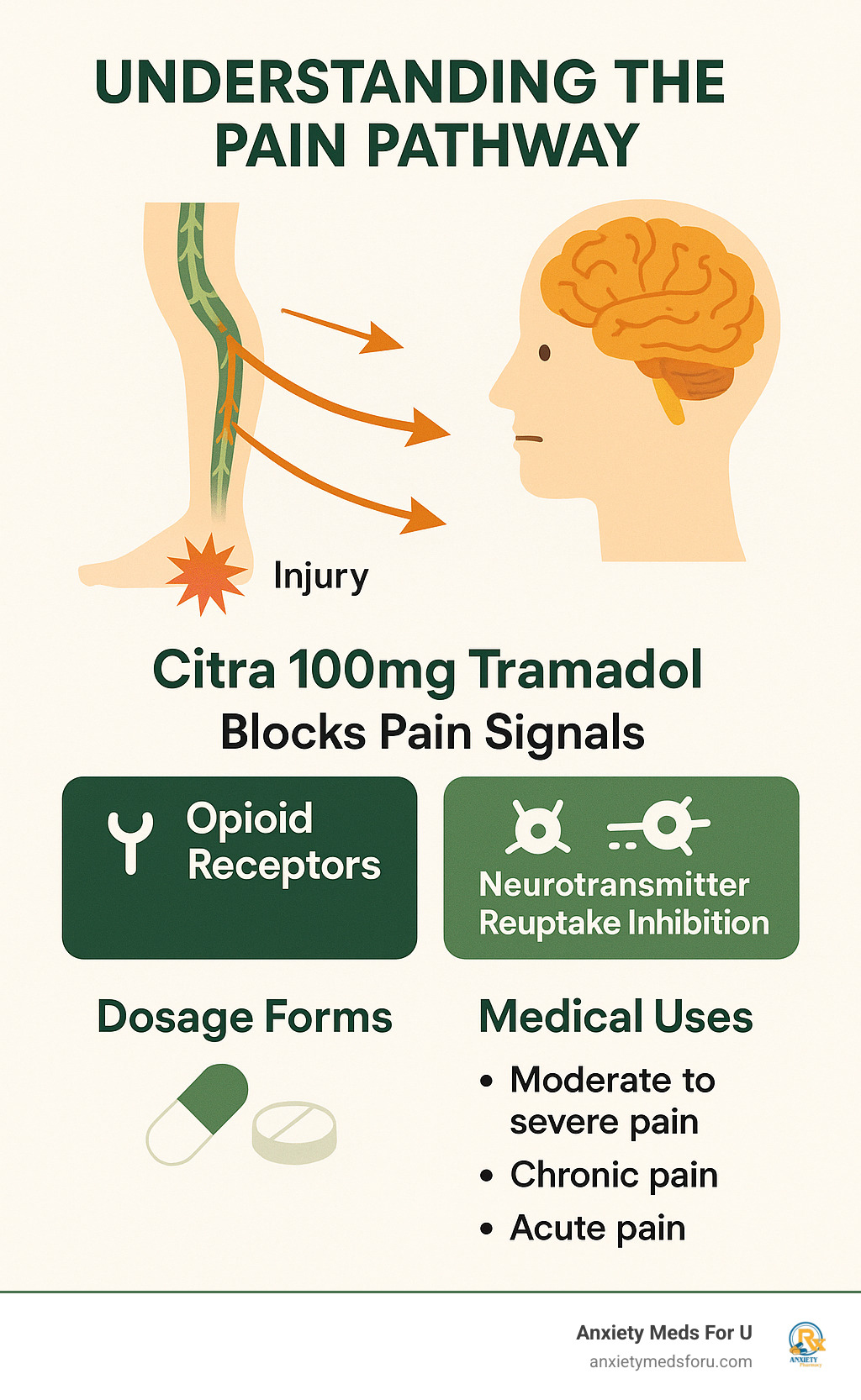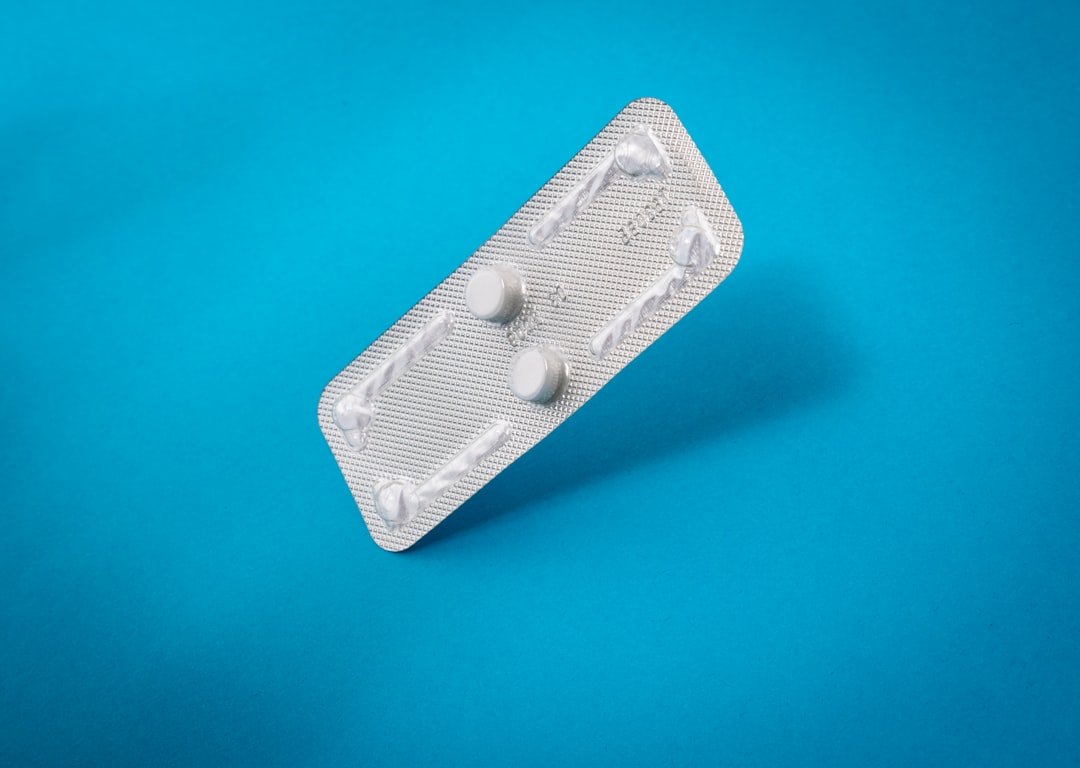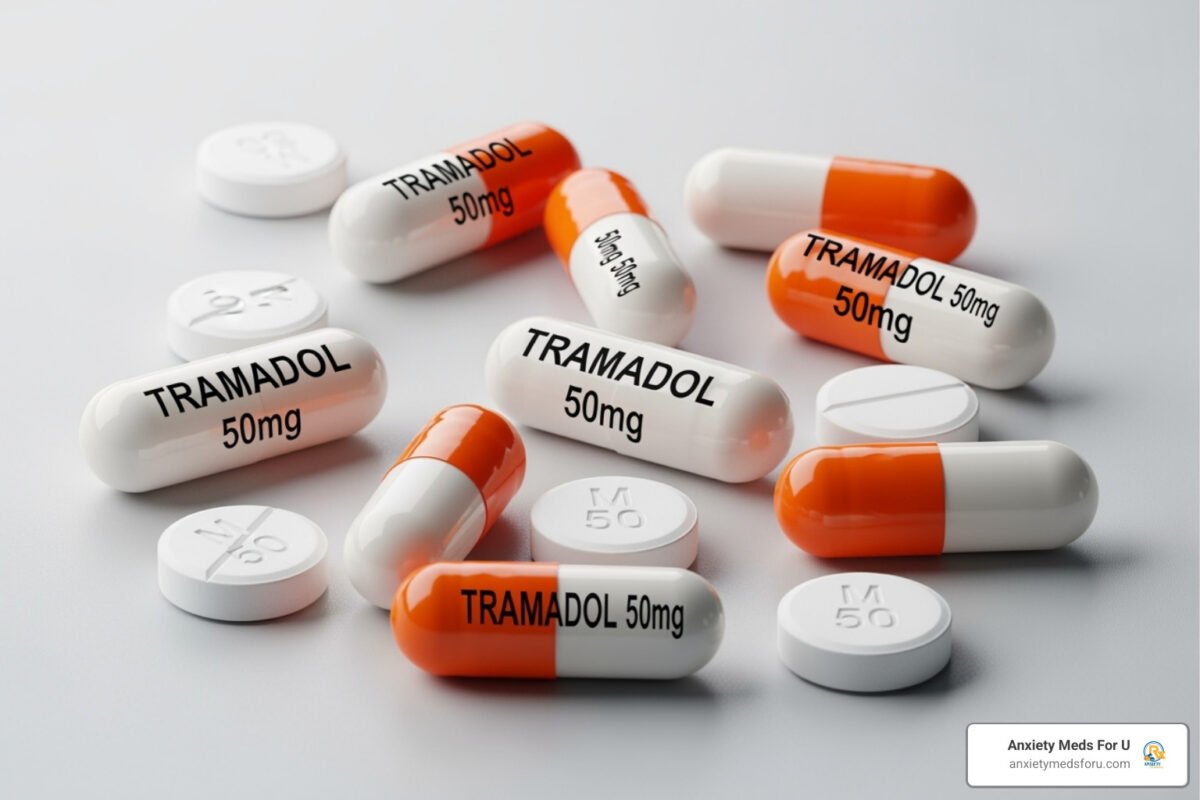Citra 100mg Uses 101

Understanding the Medical Benefits of Citra 100mg
The uses of citra 100mg center around effective pain management for moderate to severe conditions. This prescription medication, containing tramadol hydrochloride, serves multiple therapeutic purposes:
Primary Uses of Citra 100mg:
- Moderate to severe pain relief – Post-surgical recovery, injury-related discomfort
- Chronic pain management – Arthritis, fibromyalgia, long-term conditions
- Acute pain episodes – Dental procedures, musculoskeletal injuries
- Alternative pain treatment – When other medications prove ineffective or cause intolerable side effects
Citra 100mg works by targeting pain signals in your central nervous system. Unlike simple pain relievers, it combines opioid receptor activation with serotonin and norepinephrine reuptake inhibition. This dual-action approach makes it particularly effective for various pain types.
The medication is commonly prescribed when:
- Standard NSAIDs don’t provide adequate relief
- Patients need around-the-clock pain management
- Other opioid medications cause severe side effects
- Long-term pain control is necessary
Understanding proper usage is crucial for both safety and effectiveness. The medication requires careful dosing, typically starting at lower amounts and adjusting based on individual response and tolerance.
I’m John, and through years of experience helping individuals access affordable prescription medications, I’ve seen how understanding the uses of citra 100mg can transform pain management for those seeking effective relief. My background in pharmaceutical accessibility has shown me the importance of clear, actionable information for patients navigating their treatment options.

What is Citra 100mg and How Does It Work?
When exploring the uses of citra 100mg, we’re diving into a medication that contains Tramadol Hydrochloride as its active ingredient. This isn’t your typical over-the-counter pain reliever – it’s a sophisticated opioid analgesic that works directly with your Central Nervous System (CNS) to tackle pain in a unique way.
Think of pain signals like urgent text messages racing from the site of injury to your brain. Tramadol essentially intercepts these messages and changes how your brain interprets them. What makes this medication particularly fascinating is its dual mechanism of action – it doesn’t just work one way, but two.
First, Tramadol binds to mu-opioid receptors in your brain, similar to other opioid medications. But here’s where it gets interesting: it also blocks the reuptake of serotonin and norepinephrine, two important brain chemicals that help regulate pain, mood, and overall well-being. This double-action approach makes Tramadol effective for various types of pain that might not respond well to other treatments.
If you’re considering pain management options, you can explore our comprehensive selection of Pain Relief Medication to understand what might work best for your situation.
Understanding the Active Ingredient: Tramadol
Tramadol falls into the opioid classification, but it’s quite different from stronger opioids you might have heard about. It’s classified as a Schedule IV controlled substance in the United States, which means it has recognized medical benefits but also carries some potential for dependence when not used properly.
Unlike NSAIDs such as ibuprofen that primarily reduce inflammation, Tramadol works centrally – meaning it focuses on pain pathways in your brain and spinal cord rather than at the injury site itself.
Here’s something really clever about how Tramadol works: when you take it, your body metabolizes it into a more potent compound called O-desmethyltramadol. This metabolite is actually up to six times stronger at binding to those crucial mu-opioid receptors. So you’re getting pain relief from both the original medication and its more powerful breakdown product.
Immediate-Release vs. Extended-Release Forms
Understanding the different forms of Tramadol helps explain the various uses of citra 100mg depending on your specific pain situation.
Immediate-release Tramadol is like having a fast-acting rescue team for acute pain. When you’re dealing with sudden, intense discomfort from surgery, a dental procedure, or an unexpected injury, this form kicks in relatively quickly. You’ll typically take it every 4 to 6 hours as needed, making it perfect for short-term pain management.
Extended-release Tramadol takes a completely different approach. It’s designed for the long haul – releasing medication steadily throughout the day to provide consistent pain relief. This makes it ideal for chronic conditions like persistent back pain, arthritis, or fibromyalgia where you need around-the-clock management.
The extended-release version means fewer daily doses (sometimes just once a day) and more stable pain control without the ups and downs that can come with immediate-release medications. Your healthcare provider will help determine which form makes the most sense based on whether you’re dealing with acute pain that should resolve relatively quickly, or chronic pain that requires ongoing management.
The Main Uses of Citra 100mg for Pain Relief
When you’re dealing with pain that just won’t quit, the uses of citra 100mg become incredibly valuable. This medication is specifically designed for moderate to severe pain that laughs in the face of regular over-the-counter medications. Think of it as your backup plan when ibuprofen throws in the towel.
What makes Citra 100mg particularly useful is its versatility. Whether you’re recovering from surgery and feeling like you’ve been hit by a truck, or you’re managing a chronic condition that’s been your unwelcome companion for months, this medication can step up to the plate. It’s effective for post-surgery pain when you need serious relief during recovery, injury-related pain from accidents or sports mishaps, and various chronic conditions like arthritis that make daily activities feel like climbing Mount Everest.
The medication also shines when dealing with neuropathic pain – that burning, tingling, or shooting sensation that comes from nerve damage. This type of pain can be particularly stubborn, but Tramadol’s unique dual mechanism often provides relief when other treatments have failed.

Key uses of citra 100mg for Acute Pain
Acute pain is like that friend who shows up unannounced and overstays their welcome – except this friend brings excruciating discomfort instead of good conversation. This type of pain hits hard and fast, usually from a specific injury or medical procedure.
Postoperative recovery is one of the most common scenarios where Citra 100mg proves invaluable. After surgery, your body is essentially in repair mode, and the pain can be intense enough to interfere with healing and sleep. This medication helps bridge that gap, allowing you to rest and recover without being constantly reminded of every incision or procedure.
Dental procedures represent another area where this medication excels. Whether you’ve had a wisdom tooth extracted or undergone a root canal, dental pain can be absolutely miserable. The throbbing, aching sensation that seems to pulse with your heartbeat responds well to Tramadol’s pain-blocking abilities.
For musculoskeletal injuries like sprains, strains, or fractures, Citra 100mg provides targeted relief that helps you function while your body heals. These injuries often involve inflammation and direct tissue damage, creating a perfect storm of discomfort that benefits from this medication’s comprehensive approach to pain management.
Addressing Chronic Pain Conditions
Chronic pain is an entirely different beast – it’s the houseguest that never leaves and slowly wears down your patience, energy, and quality of life. This is where the uses of citra 100mg really demonstrate their long-term value, especially with extended-release formulations that provide consistent relief around the clock.
Fibromyalgia patients often find significant relief with this medication. This condition creates widespread pain that feels like your entire body is bruised, combined with fatigue that makes simple tasks feel overwhelming. Tramadol’s ability to work on both pain pathways and neurotransmitters like serotonin makes it particularly effective for this complex condition.
Back pain, whether from herniated discs, sciatica, or general wear and tear, represents one of the most common reasons people seek pain relief. Chronic back pain can turn simple activities like sitting at a desk or getting out of bed into major challenges. Citra 100mg helps restore some normalcy to daily life.
Osteoarthritis – the “wear and tear” arthritis that comes with age and use – creates persistent joint pain and stiffness that can make movement painful. This medication helps manage the constant ache that can make even gentle activities uncomfortable.
When other treatments have failed to provide adequate relief, this medication often becomes a crucial component of comprehensive pain management. For detailed information about this specific medication and how it might help your situation, visit our page with more info about Citra 100mg.
How to Use Citra 100mg Safely: Dosage and Administration
When it comes to the uses of citra 100mg, knowing how to take it safely is just as important as understanding what it treats. Think of proper medication use like following a recipe—you wouldn’t add extra salt hoping to make dinner taste better, would you? The same principle applies here.
Your healthcare provider has given you specific instructions for a reason, and following them precisely is your best bet for effective pain relief without unwanted complications. Never take more than prescribed or increase your dosing frequency, thinking it’ll work faster or better. It won’t—but it will increase your risk of serious side effects.
Here’s something crucial: always swallow your tablets or capsules whole. I know it might be tempting to break them if you’re having trouble swallowing, but don’t do it. Breaking, crushing, or chewing can release too much medication at once, which can be dangerous.
You can take Citra 100mg with or without food—whatever works better for your stomach. Some people find taking it with a light snack helps prevent nausea, while others prefer an empty stomach. The key is consistency. Pick what works for you and stick with it.

Recommended Dosage and Treatment Duration
Dosing isn’t a one-size-fits-all situation. Your doctor considers your pain type, severity, medical history, and how your body might respond before deciding on your dose. Think of it as a personalized approach to your pain management.
For immediate-release forms, most adults start somewhere between 50mg to 100mg every 4 to 6 hours as needed. But here’s where it gets interesting—some people actually start much lower, maybe just 25mg once daily, then slowly work up by 25mg every three days. This gradual increase, called titration, helps your body adjust while minimizing side effects.
The maximum daily dose is typically 400mg for most adults. However, if you’re over 75, your doctor will likely cap it at 300mg daily since our bodies process medications more slowly as we age.
Extended-release forms work differently. You might start with 100mg once daily, then increase by 100mg every five days if needed, up to that 300mg daily maximum. The beauty of extended-release is the convenience—once-a-day dosing for consistent pain control.
Treatment length varies dramatically depending on your situation. Acute pain from surgery or an injury might only need a few days to weeks of treatment. Chronic conditions like arthritis or fibromyalgia might require months or longer with regular monitoring.
Here’s something really important: don’t stop suddenly, especially after taking it for weeks or months. Your doctor will create a tapering schedule to gradually reduce your dose, preventing withdrawal symptoms that can make you feel pretty miserable.
What to Do If You Miss a Dose
Life gets busy, and sometimes we forget things—including our medications. If you miss a dose of Citra 100mg, don’t stress about it too much.
Take the missed dose as soon as you remember, unless it’s almost time for your next scheduled dose. In that case, just skip the missed one entirely and get back on your regular schedule. Your body will thank you for maintaining consistency.
The golden rule here is simple: never double up on doses. Taking two doses close together won’t give you better pain relief, but it will significantly increase your risk of side effects like dizziness, nausea, or more serious complications.
If you’re someone who frequently forgets medications, consider setting phone alarms or using a pill organizer. These simple tools can help you stay on track with your pain management routine.
For more helpful medication management tips and insights, browse through our resources at More info on our Blog.
Potential Side Effects and Critical Precautions
Understanding the potential side effects of Citra 100mg is essential for safe use. While this medication can be incredibly effective for pain relief, it’s important to know what to expect and when to be concerned. Think of it as being prepared for a journey—you want to know the possible bumps along the way so you can handle them confidently.
The good news is that many people tolerate Citra 100mg well, especially when used as directed. However, like any powerful medication, it does come with some risks that we need to discuss openly and honestly.

Common and Serious Side Effects to Watch For
Most side effects from Citra 100mg are manageable and often fade as your body adjusts to the medication. The most common ones include dizziness (especially when standing up quickly), nausea, constipation, headache, and drowsiness. You might also notice a dry mouth. These effects are usually mild and temporary, but don’t hesitate to mention them to your doctor if they become bothersome.
Constipation deserves special mention because it’s extremely common with opioid-like medications. Staying hydrated, eating fiber-rich foods, and gentle exercise can help. Your doctor might also recommend a stool softener if this becomes an ongoing issue.
However, some side effects require immediate medical attention. Seizures are rare but possible, especially if you have a history of seizures or are taking other medications that lower the seizure threshold. Slow or shallow breathing is particularly serious—if you notice this, especially with extreme drowsiness, seek emergency help immediately.
Serotonin syndrome is another serious concern, particularly if you’re taking antidepressants or other medications that affect serotonin levels. Watch for symptoms like agitation, hallucinations, rapid heartbeat, fever, severe muscle stiffness, or coordination problems. Severe allergic reactions can also occur, showing up as rash, swelling of the face or throat, or difficulty breathing.
Other serious effects include reduced adrenal function (causing fatigue, weakness, and low blood pressure), significant drops in blood pressure when standing, and in rare cases, dangerously low sodium or blood sugar levels. For the most comprehensive information, keep the FDA Medication Guide handy as a reference.
Key Drug Interactions and Contraindications
Before starting any medication regimen involving the uses of citra 100mg, your doctor needs to know about every single thing you’re taking—prescriptions, over-the-counter medications, herbal supplements, and yes, even that occasional glass of wine.
Alcohol is absolutely off-limits while taking Citra 100mg. Combining them can lead to dangerous sedation, breathing problems, and even coma. The same goes for other central nervous system depressants like benzodiazepines, sleep medications, and muscle relaxers. These combinations can be life-threatening.
Antidepressants present another major concern. SSRIs, SNRIs, and MAOIs can interact with Tramadol to cause serotonin syndrome. If you’ve taken an MAOI within the last 14 days, Tramadol is completely contraindicated. Even herbal supplements like St. John’s Wort can cause problems.
Your medical history plays a crucial role in determining whether Citra 100mg is right for you. Liver or kidney disease affects how your body processes the medication, potentially leading to dangerous buildup. Seizure disorders are typically a no-go because Tramadol can lower your seizure threshold. Severe lung problems like asthma or COPD can be worsened by the medication’s effects on breathing.
Why might your doctor prescribe this medication to you but not your friend with similar pain? It’s all about individual risk assessment. Your unique combination of health conditions, current medications, and medical history creates a personalized safety profile that guides treatment decisions.
Understanding Tolerance, Dependence, and Addiction
Let’s clear up some confusion about three important terms that often get mixed up: tolerance, dependence, and addiction. Understanding these differences is crucial for anyone considering the uses of citra 100mg for pain management.
Tolerance is your body’s natural adaptation to a medication. Over time, you might need a higher dose to achieve the same pain relief. This is a normal physiological response, not a character flaw or sign of addiction.
Physical dependence means your body has adapted to having the medication present. If you stop suddenly, you’ll likely experience withdrawal symptoms like anxiety, insomnia, nausea, or sweating. This is why we always recommend tapering off gradually under medical supervision rather than stopping cold turkey.
Addiction is entirely different—it’s a complex brain disease involving compulsive drug-seeking behavior despite harmful consequences. While Tramadol’s addiction risk is lower than stronger opioids, it still exists, especially with misuse or abuse. This is why it’s classified as a Schedule IV controlled substance.
To minimize these risks, always follow your prescription exactly. Never take more than prescribed, never share your medication (it’s dangerous and illegal), and store it securely away from children and others. When you no longer need the medication, proper disposal is essential—look for community drug take-back programs or mix unused pills with something unpleasant like coffee grounds before throwing them away.
Safe storage isn’t just about keeping the medication effective—it’s about preventing misuse and protecting your family and community. For more detailed information about Tramadol risks and safety measures, Learn more about Tramadol risks provides excellent additional resources.
Frequently Asked Questions About Citra 100mg
I get asked these questions all the time by people who are starting Citra 100mg or considering it for their pain management. These are real concerns from real people, and I want to make sure you have clear, honest answers that help you feel more confident about your treatment decisions.
Can I drive after taking Citra 100mg?
Here’s the thing about driving while taking Citra 100mg—it’s not a simple yes or no answer. This medication can cause drowsiness, dizziness, and impaired judgment, which are exactly the things you don’t want when you’re behind the wheel of a car.
My strong recommendation? Don’t drive or operate any heavy machinery until you know exactly how this medication affects you personally. Even if you feel completely fine, your reaction time or ability to concentrate might be subtly compromised in ways you don’t immediately notice.
When you first start taking Citra 100mg, give yourself at least a few days to see how your body responds. Some people feel drowsy for the first week, while others adjust quickly. Avoiding hazardous activities during this adjustment period isn’t just smart—it could save lives.
If you’re feeling even slightly foggy or “off,” ask a friend for a ride, use public transportation, or work from home if possible. It’s always better to be safe than sorry, and that slight inconvenience is nothing compared to the potential consequences of impaired driving.
What are the signs of a Citra 100mg overdose?
Recognizing an overdose is absolutely critical because it can be life-threatening. If you even suspect someone has taken too much Citra 100mg, call 911 immediately—don’t wait to see if symptoms get worse.
The most dangerous sign to watch for is slow or shallow breathing, or breathing that stops altogether. This is a medical emergency. Other serious overdose symptoms include extreme sleepiness where the person is difficult to wake up or completely unresponsive, pinpoint pupils that look unusually small, and loss of consciousness.
You might also notice a slowed heartbeat, muscle weakness, cold and clammy skin, or the person might seem completely limp. These are all signs that the body’s vital functions are being dangerously suppressed.
Naloxone can reverse opioid overdoses, including those from Tramadol, particularly the life-threatening breathing problems. If you or someone in your household is taking Citra 100mg regularly, it’s worth discussing with your doctor whether you should keep Naloxone on hand and learn how to use it.
Why is it important to taper off Citra 100mg instead of stopping suddenly?
Your body is remarkably adaptable, and when you’ve been taking Citra 100mg for a while, it adjusts to having that medication present. Stopping suddenly is like slamming on the brakes—it can send your system into shock and cause some pretty uncomfortable withdrawal symptoms.
These symptoms can include anxiety and feeling agitated, insomnia and other sleep problems, nausea and stomach upset, muscle aches, sweating, and general irritability. Nobody wants to deal with that rollercoaster of discomfort when there’s a much gentler way to stop the medication.
Gradual reduction under your doctor’s supervision allows your body to adjust incrementally. Your doctor will create a tapering schedule that slowly reduces your dose over time—maybe dropping from 100mg to 75mg for a week, then to 50mg, and so on. This approach helps prevent withdrawal symptoms and also reduces the chance of rebound pain.
The timeline for tapering varies from person to person. Some people need a few weeks, others might need a couple of months. Your doctor will base this on how long you’ve been taking the medication, your current dose, and how your body typically responds to changes.
Never try to create your own tapering schedule or stop cold turkey without medical guidance. Your doctor has the experience to guide you through this process safely and comfortably.
Conclusion: Final Thoughts on the Uses of Citra 100mg
After exploring everything from basic mechanisms to safety precautions, it’s clear that the uses of citra 100mg extend far beyond simple pain relief. This medication serves as a bridge between over-the-counter options that don’t quite cut it and stronger opioids that might be overkill for your situation. Whether you’re dealing with the sharp aftermath of dental surgery or the persistent ache of chronic arthritis, understanding how to use this medication safely can genuinely transform your quality of life.
The key takeaway here is balance. Yes, Citra 100mg can provide excellent pain relief for both acute episodes and chronic conditions, but that relief comes with responsibilities. Taking it exactly as prescribed, being aware of potential interactions, and knowing when to call your doctor aren’t just suggestions—they’re essential parts of your treatment plan.
We’ve seen how this medication’s dual-action approach makes it particularly effective for various pain types, from post-surgical discomfort to neuropathic pain that other treatments struggle to touch. But we’ve also been honest about the risks: the possibility of side effects, the importance of avoiding alcohol, and the need for careful tapering when it’s time to stop.
At Anxiety Meds For U, we believe that effective pain management shouldn’t break the bank or involve complicated hoops to jump through. That’s why we focus on providing significant savings of up to 80% while ensuring discreet and fast delivery right to your door. We understand that dealing with pain is challenging enough without worrying about accessibility or privacy concerns.
Your journey with pain management is personal, and having reliable access to medications like Citra 100mg can make all the difference. If you’re ready to take control of your pain relief needs with the convenience and savings you deserve, we invite you to Buy Citra Online for your pain relief needs through our trusted platform. Because everyone deserves to live comfortably, without the constant shadow of pain holding them back.













